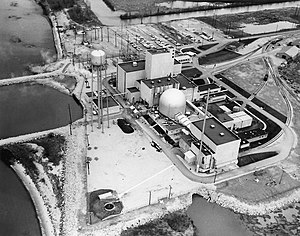| Fermi 1 | |
|---|---|
 Fermi 1 as it appeared in 1971 | |
 | |
| Country | United States |
| Coordinates | 41°57′38″N 83°15′28″W / 41.96056°N 83.25778°W |
| Status | Decommissioned |
| Construction began | December 1956 |
| Commission date | August 6, 1966 (first net power) |
| Decommission date | December 31, 1975 |
| Operator(s) | Detroit Edison |
| Nuclear power station | |
| Reactor type | Fast breeder reactor |
| Reactor supplier | PRDC |
| Power generation | |
| Units decommissioned | 1 x 150 MWe |
Fermi 1 was the United States' only demonstration-scale breeder reactor, built during the 1950s at the Enrico Fermi Nuclear Generating Station on the western shore of Lake Erie south of Detroit, Michigan. It used the sodium-cooled fast reactor cycle, in which liquid sodium metal is used as the primary coolant instead of typical nuclear reactor designs cooled by water. Sodium cooling permits a more compact core, generating surplus neutrons used to produce more fission fuel by converting a surrounding "blanket" of 238U into 239Pu which can be fed back into a reactor. At full power, it would generate 430 MW of heat (MWt), or about 150 MW of electricity (MWe).
The design and construction of Fermi 1 was led by Walker Lee Cisler, president of Detroit Edison. Cisler believed that the breeder cycle would dominate the future commercial market because it would provide an effectively limitless supply of fuel, and he championed efforts to produce Fermi 1 based on the design of the small experimental EBR-I in Idaho. His efforts were supported by Lewis Strauss, chair of the U.S. Atomic Energy Commission (AEC), who was a strong advocate of private companies entering the nuclear field.
On November 29, 1955, EBR-I suffered a partial meltdown for reasons that were not completely understood. Construction licensing for Fermi 1 began in January 1956. The AEC review panel recommended that the design should not proceed until the problems with EBR, and breeder design in general were better understood through testing on newer experimental systems like EBR-II. When their report was cited in congressional hearings, Strauss refused to discuss it and approved construction. This led to a firestorm of debate within Congress and the press, along with a series of lawsuits by the United Auto Workers that briefly led to its construction license being revoked.
Construction was delayed by several years and the budget doubled. Operation had been planned for 1959 or early 1960 but Fermi 1 achieved criticality on August 23, 1963. While slowly increasing its power over the next two years, on October 5, 1966 it suffered a partial meltdown when the flow of sodium was disrupted by blockage of the inlet holes at the bottom of the reactor. The problem was detected early enough to safely scram the reactor and there was no radioactive release outside the containment building. The site was shut down for repairs and restarted in July 1970. It ran only until closing again on November 27, 1972, and was officially decommissioned on December 31, 1975.
© MMXXIII Rich X Search. We shall prevail. All rights reserved. Rich X Search
